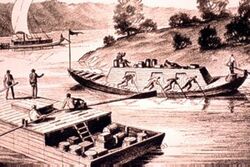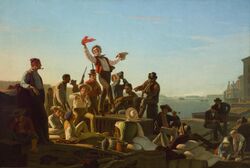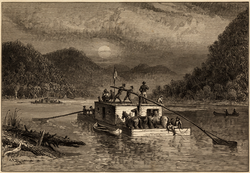Engineering:Flatboat
A flatboat (or broadhorn) was a rectangular flat-bottomed boat with[1] square ends used to transport freight and passengers on inland waterways in the United States . The flatboat could be any size, but essentially it was a large, sturdy tub with a hull.
A flatboat was almost always a one-way (downstream) vessel, and was usually dismantled for lumber when it reached its destination.[2]
Early history
The flatboat trade first began in 1781, with Pennsylvania farmer Jacob Yoder building the first flatboat at Old Redstone Fort on the Monongahela River. Yoder's ancestors immigrated from Switzerland, where small barges called weidlings are still common today, having been used for hundreds of years to transport goods downriver. Yoder shipped flour down the Ohio River and Mississippi River to the port of New Orleans. Other flatboats would follow this model, using the current of the river to propel them to New Orleans where their final product could be shipped overseas. Through the antebellum era, flatboats were one of the most important modes of shipping in the United States.[3]
The flatboat trade before the War of 1812 was less organized and less professional than during later times. Flatboats were generally built and piloted by the farmers whose crops they carried. They were limited to 20 feet (or approximately 6 meters) in width in order to successfully navigate the river, but could range from 20 to 100 feet (or approximately 6 to 30 meters) in length. Flatboats could be built by unskilled farmers with limited tools and training, which made them an ideal mode of transport for isolated farmers living in the Old Northwest and the Upper South. Farmers could make the journey down the river after the harvest. The boats themselves were usually salvaged for lumber at New Orleans, because they could not easily make the journey upriver. A boatman's return journey up the river was long and usually arduous. Passage on a (human-powered) keelboat was expensive and took weeks to make the journey up the Mississippi. Returning to the northern reaches on foot required about three months.[4]
A flatboat itself was a serious investment for a Midwestern farmer. One generally cost about $75 to construct in 1800 (which was equivalent to $1,129.85 in 2019), but could carry up to $3,000 worth of goods.[5] These flatboats could typically be salvaged for around $16 in New Orleans, recouping some of the initial investment.[6] Flatboats carried a variety of goods to New Orleans, including agricultural products like corn, wheat, potatoes, flour, hay, tobacco, cotton, and whiskey. Livestock such as chickens, cows, and pigs also made their way down the Mississippi in flatboats. Indiana native May Espey Warren recalled that as a young girl she saw a flatboat loaded with thousands of chickens headed down the Mississippi. Other raw materials from the Old Northwest, like lumber and iron, were also sent down the Mississippi to be sold in New Orleans.[7]
Many American cities along the river network of the Mississippi boomed due to the opportunities that the flatboat trade presented. New Orleans was the final destination for most flatboats headed down the Mississippi, and it was from there that most of the goods were shipped on the oceans. Cincinnati, another major American trading city, first built itself on the flatboat trade. Its large sawmills produced most of the heavy lumber sent downriver on flatboats, and it also became a large hub for the pork trade. Other cities, like Memphis, Tennessee and Brownsville, Pennsylvania became hubs for outfitting and supplying flatboat traders.[7]
The flatboat trade also led to a series of cultural and regional exchanges between the North and the South. Many Northern flatboatmen had not seen the Deep South before, and rural farmers of the time generally did not travel. Flatboatmen brought tales of antebellum mansions lining the Mississippi and of the Cajun culture of lower Louisiana. They also brought back exotic foods such as bananas, and animals such as parrots.[4] Abraham Lincoln served as a flatboatman twice, in 1828 and 1831. It was on these journeys that he first witnessed slavery, and in New Orleans he also saw a slave auction firsthand. Lincoln would later recall these journeys as essential in shaping his personal views on slavery and the slave trade.[8]
Advent of steamboats
The invention of the steamboat greatly reduced the costs of flatboat journeys, and caused the trade to boom through the antebellum period. Introduced to the Mississippi in the 1810s, the steamboat greatly reduced the time of the return journey for flatboat crews. After reaching New Orleans, many flatboat crews scuttled their craft and bought passage on steamboats upriver. What had once been a three-month hike for many flatboaters now took only days. These reduced labor costs saw flatboat operating costs plummet and profits boom. In some cases steamboats would also drag cargo-carrying flatboats upriver, allowing flatboat operators to profit on the return journey as well. These uses of steamboats caused the flatboat industry to grow from 598 arrivals in New Orleans in 1814 to 2,792 arrivals in 1847.[9]
The steamboat also changed the nature of flatboat crews, making them more professional and more skilled. Returning upriver on steamboats allowed flatboat crews to make multiple journeys per year, which meant that a crew could earn a living wage simply by flatboating. These crews were known as "agent boatmen," as opposed to the earlier "dealer boatmen" or "peddler boatmen" for whom flatboating was only a seasonal job. This change ended up benefiting the flatboat industry significantly, because it seriously reduced wreckage and loss of cargo. River improvements also helped, and experienced flatboat crews were able to reduce cargo losses from $1,362,500 in 1822 to $381,000 in 1832.[9]
Decline
The flatboat trade stayed vigorous and lucrative throughout the antebellum period, aided by steamboats (and later by railroads) in returning crews upriver. However, these same technologies, which earlier had made the flatboat trade significantly more efficient, would eventually overtake the flatboat trade along the Mississippi and render flatboats obsolete. Steamboats and railroads simply carried freight much more quickly than flatboats, and could bring cargo upriver as well as downriver. By 1857, only 541 flatboats reached New Orleans, down from 2,792 in 1847, and also fewer than the 598 flatboats that had traveled down the Mississippi in 1814.[7]
See also
- Barge
- Boat
- Galiot
- Keelboat
- Narrow boat
- Punt
- Pünte
- Redstone Old Fort
- Mississippi River Squadron, where flat bottom vessels were extensively used during the American Civil War.
References
- Nancy Jordan Blackmore (2009). "Various Website History pages". Big Bone Lick Historical Society. http://www.janessaddlebag.org/about-us/big-bone-lick-area-history.
Footnotes
- ↑ Nancy Jordan Blackmore (2009). "Flatboat History". Big Bone Lick Historical Society, Janes Saddlebag. http://www.janessaddlebag.org/about-us/big-bone-lick-area-history/flatboat-history.html. "There were a variety of specialized flatboats [eventually developed] to ship cargo to world markets. Some [later, meaning after steam boats became common] flatboats were built with raked bows to be used on return trips alongside steamboats, serving as 'fuel flats', first hauling wood, then coal. These flatboats with raked bows evolved into coal boats. [Later,] Coal boats were tied together in fleets to be pushed by steamboats. Those coal boats evolved into the steel barges of today [plying the coal fields of the Ohio River watershed]."
- ↑ Nancy Jordan Blackmore (2009). "Ohio River Info and History". Big Bone Lick Historical Society, Janes Saddlebag. http://www.janessaddlebag.org/about-us/big-bone-lick-area-history/ohio-river-info-and-history.html. "The flatboat was the cheapest of the many types of boats used and became the standard conveyance for families moving west. All of the boats in this period were hand-powered, with poles or oars for steering, and usually floated with the current. They were not intended for round trips since the settlers used them only to get to their new homes and then broke them up for their lumber."
- ↑ Blackmore, Nancy Jordan. "Various Website History pages". Big Bone Lick Historical Society. http://www.janessaddlebag.com/about-us/big-bone-lick-area-history/flatboat-history.html.
- ↑ 4.0 4.1 Records, T.W. (December 1946). "Flatboats". Indiana Magazine of History. 4 42.
- ↑ Meyer, Balthasar Henry, et al. History of Transportation in the United States before 1860. Washington 1917, pp.110
- ↑ Berry, "Western Prices Before 1861". London, 1943, pp.23-24
- ↑ 7.0 7.1 7.2 Carmony, Donald F.; Sam K. Swope (December 1964). "Flatboat Building on Little Raccoon Creek, Parke County, Indiana". Indiana Magazine of History. 4 60.
- ↑ Allen, Michael (August 1990). "The Riverman as a Jacksonian Man". Western Historical Quarterly 21 (3): 305–320. doi:10.2307/969705.
- ↑ 9.0 9.1 Mak, James; Gary M. Walton (June 1973). "The Persistence of Old Technologies: The Case of Flatboats". The Journal of Economic History. 4 33 (2): 444–451. doi:10.1017/S0022050700076695.
External links
 |





